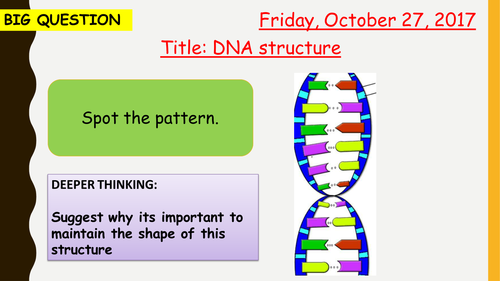



AQA spec link: 6.1.5
Relevant chapter: B13 Genetics and reproduction. AQA Biology third edition textbook-Page 204-205.
Students should be able to describe DNA as a polymer made from four different nucleotides. Each nucleotide consists of a common sugar and phosphate group with one of four different bases attached to the sugar. DNA contains four bases, A, C, G and T. A sequence of three bases is the code for a particular amino acid. The order of bases controls the order in which amino acids are assembled to
produce a particular protein.
The long strands of DNA consist of alternating sugar and phosphate sections. Attached to each sugar is one of the four bases. The DNA polymer is made up of repeating nucleotide units.
(HT only) Students should be able to: •• recall a simple description of protein synthesis •• explain simply how the structure of DNA affects the protein made •• describe how genetic variants may influence phenotype: a) in coding DNA by altering the activity of a protein: and b) in non-coding DNA by
altering how genes are expressed.
(HT only) In the complementary strands a C is always linked to a G on the opposite strand and a T to an A.
(HT only) Students are not expected to know or understand the structure of mRNA, tRNA, or the detailed structure of amino acids or proteins.
(HT only) Students should be able to explain how a change in DNA structure may result in a change in the protein synthesised by a gene.
(HT only) Proteins are synthesised on ribosomes, according to atemplate. Carrier molecules bring specific amino acids to add to the growing protein chain in the correct order.
(HT only) When the protein chain is complete it folds up to form a unique shape. This unique shape enables the proteins to do their job as enzymes, hormones or forming structures in the body such as collagen.
Get this resource as part of a bundle and save up to 42%
A bundle is a package of resources grouped together to teach a particular topic, or a series of lessons, in one place.
AQA Biology-SEPARATE topics PAPER 2 ONLY
Separate Sciences B10.4, B10.5 & B10.6 B11.9 & B11.10 B12.1, B12.2, B12.3, B12.4. B12.5 B13.4, B13.5 & B13.6 B14.5 & B14.6 B15.1, B15,2, B15.3 & B15.4
AQA new specification-B13 Reproduction bundle-Biology/separate science
Due to popular demand I have uploaded a B13 bundle. This bundle contains the content for BIOLOGY/SEPARATE science students. It includes all the resources you need to teach the B13 Reproduction topic. If you're teaching this topic (B12) to combined science students I've uploaded a separate bundle for it. Lessons have been done in accordance to the specification requirements. Videos embedded for ease of use, paper friendly resources attached. Search the individual lessons for more information on the lesson content. Save 42% by purchasing this bundle. Higher topics included. Total 11 lessons + Past paper question pack on mitosis and meiosis. L1 = types of reproduction L2 = cell division and sexual reproduction L3 = the best of both worlds L4 = DNA and the genome L5a = DNA structure L5b = protein synthesis L6 = gene expression and mutation L7 = inheritance in Action L8 = more about genetics L9 = inherited disorders L10 = screening for genetic disorders
Something went wrong, please try again later.
Okay for the lower end but not much in terms of real stretch and challenge. Covers the basics
I bought this as part of a bundle and has really saved me lots of time in this season of mock marking and report writing. Thanks, great resource!
Report this resourceto let us know if it violates our terms and conditions.
Our customer service team will review your report and will be in touch.
